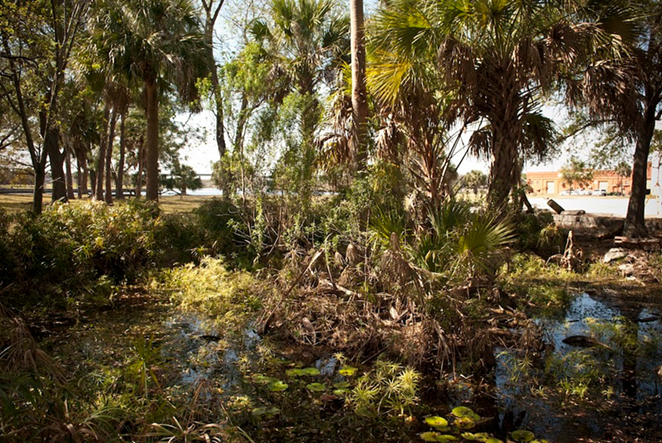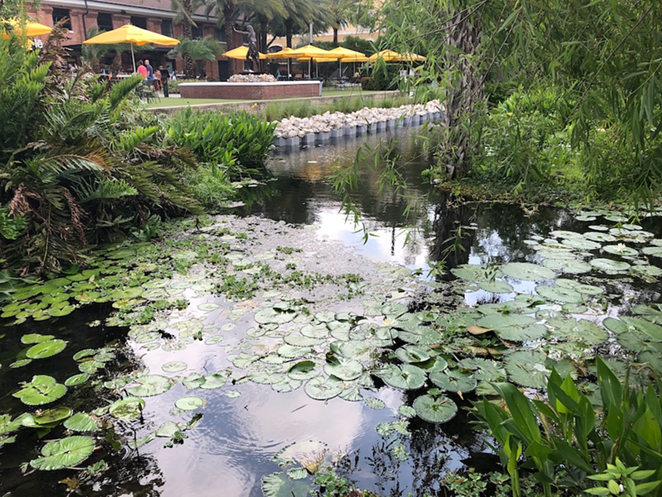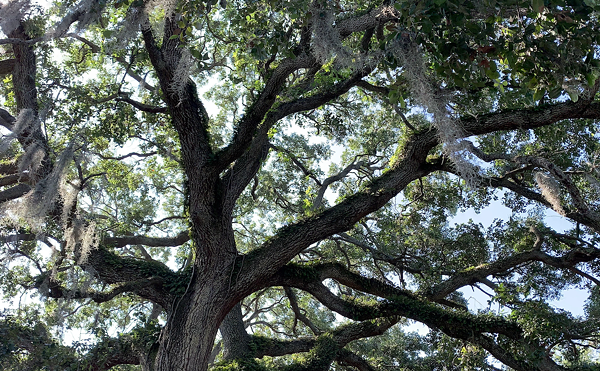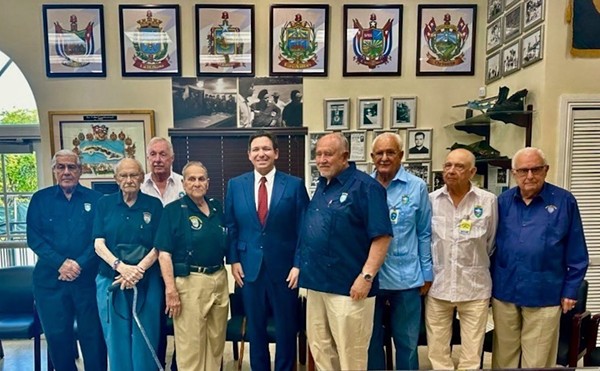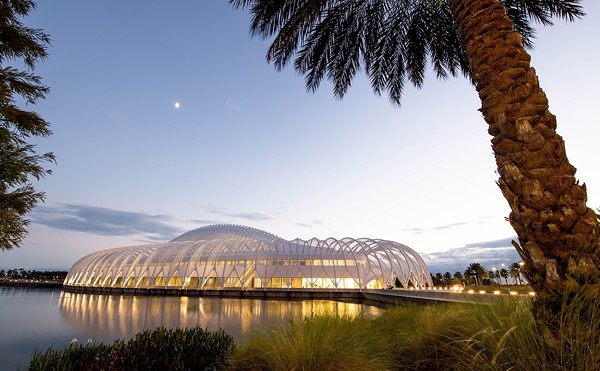
Saturday morning at Tampa’s Water Works Park is a soothing symphony of city sounds. Perched along a winding sidewalk that leads down to the Hillsborough River, I hear walkers conversing, traffic rumbling along Highland Avenue, and forks clattering on plates that bear Florida delicacies on the patio of Ulele Restaurant and Brewery. Every two minutes, a wet crash and squeals of delight ring from the park’s splash pad as a giant yellow bucket dumps cascades of water onto a knot of eager kids below. And somewhere, quiet underneath this pleasant din, there is the patient sound of water once again bubbling up from deep in the earth, tumbling over a weir, and wending its way back to the Bay.
RELATED
Then and Now: Historic photo project shows how much Tampa has changed in the last century
When the park opened in 2014, it was a culmination of decades of planning and remediation work designed to transform a disused storage yard for city vehicles into a green space that celebrated the city’s relationship to the river, which runs along its western edge. “A lot of times, people didn’t even know the river was there,” recalls Karla Price, a landscape architect for Tampa’s Department of Parks and Recreation.
“We wanted to create something that felt like you were in a natural environment,” Price told Creative Loafing Tampa Bay, pointing out the living shoreline along the park’s seawall, where mangroves are beginning to grow, and legacy oaks that shade the Riverwalk, making this spot a full 10 F degrees cooler than anywhere else on the trail.
But perhaps the most miraculous transformation of all has been that of Ulele Spring, the beating heart of this urban oasis. Ulele now pulses out 672,000 gallons of cool, clear water per day through three ponds where native plants flourish and birds, fish, and manatees thrive. This is a dramatic change from just eight years ago, when writer Rick Kilby (“Florida’s Healing Waters: Gilded Age Mineral Springs, Seaside Resorts, and Health Spas,” 2020) paid a visit to the site. Back then, he found only an overgrown pool where water gurgled out of a pipe and disappeared back into the ground before reaching the river. Tom Ries, president of Ecosphere Restoration Institute, the nonprofit that oversaw the park’s remediation, tells a similar story: while he working on a different restoration project upriver, a neighbor suggested he seek out the spring by the old water works, which did not even appear in water management district records. The spring had literally vanished from the map.
As Ries and Price would learn, this forsaken spot was once a well known landmark in Tampa’s “first suburb” of Tampa Heights. As the city began to grow, so did its thirst for a municipal water supply, and the water works station that now houses Ulele restaurant was constructed next to a small but productive source, then known as Magbee Spring, in 1889. In those early years, the spring supplied about 250,000 gallons of water per day. Old newspaper accounts describe this stretch of riverside as a “romantic resort” beloved by local residents, “a rich setting for the stream of pellucid water which gushes from a rocky cavern in the hillside.” Pictures from the 1920s show visitors picnicking and rowing on a lily pond constructed around the spring. But when a modern water filtration system was installed upstream in 1924, the site gradually went to other uses, including a fish processing plant, a shipyard, a police station, and a garage for city vehicles. Over time, the spring was piped and buried, and its place in local memory largely forgotten.

Magbee (officially renamed Ulele in 2006) is just one of Tampa’s historic springs to have fallen into neglect over the years. Ybor’s Government Spring, which supplied water to Tampa’s early settlers as well as to the Florida Brewery (Tampa’s first), now lies somewhere underground, likely beneath the old Florida Brewing Company building. In the first half of the 20th century, Purity Springs, just off of River Shore Drive, supported the largest private water system in the county, supplying thousands of homes north of Hillsborough Avenue. It is now a secluded neighborhood park. Perhaps the most tragic case is Sulphur Springs, once a tourist attraction that drew visitors from around the country. The spring was closed to swimming in 1986 due to high bacteria levels, largely caused by garbage and pollution dumped into nearby sinkholes (how Florida is that?) that help recharge the spring’s flow. While visitors to Sulphur Springs can now splash in a chlorinated pool, the spring itself languishes behind a chain link fence, under a thick, brown layer of algae.
The city still relies on groundwater (along with river water and desalinated water) for its supply, but it now taps more distant wellfields in Pasco, Pinellas, and Hillsborough counties. The water under our feet has largely been walled over, piped, and forgotten. “There’s no telling how many springs we have lost because of progress,” Kilby laments. “And the reality is, the water table has fallen so much, some might have stopped flowing altogether.”
In this light, the recovery of Ulele offers a remarkable counterpoint to a persistent story of degradation and abandonment of urban springs. Beneath Ulele’s crystalline surface, Ries tells me, biologists have found 33 different species of crustaceans and fish, and 35 individual manatees have been observed feeding and sheltering. The restored spring provides an estuarine habitat, critical for young fish, that has all but disappeared as dozens of other small spring runs in the city have been piped over or channeled away. Ries sees Ulele as a crucial connection point, providing public education that generates the support that Florida’s imperiled springs need. Kilby takes it one step further. “It’s a symbol of hope. Ulele is a model for what we can do with a lot of other springs. It shows you can bring a spring back if you do the right things.”
But the problems facing Florida’s springs are so enormous: runoff and leakage from continuing agricultural, residential, commercial development, combined with increasing withdrawals from the Floridan Aquifer, on top of less predictable weather patterns accelerated by climate change—it all adds up to a losing equation for Florida’s springs. The Florida Springs Institute estimates that waters in roughly 80% of the state’s 1,000-plus springs currently exceed the “healthy” level of .35 milligrams of nitrates per liter. And while Florida has allocated $150 million toward springs restoration in the last three years, environmental advocacy groups set the price tag for repairing Florida’s springs in the tens of billions of dollars. The restoration of Ulele Springs alone cost $650,000 (plus an additional $200,000 in additional enhancements since 2014) and required the support of eight government and nonprofit agencies. Against these odds, what hope can one tiny restored connection really offer us?
I remember the first time I swam in a Florida spring, at Volusia County’s Blue Springs State Park: how I floated facedown through turquoise-tinted water, gliding cautiously over the mouth of a cavern that plunged down to a great underground river, with countless unmapped tributaries, weaving through the karst below.
“When you swim over a cave and you can’t see the bottom,” says Kilby, “you feel like you’re connected to something bigger than yourself. It’s like a little window.”
And while nobody is diving into the water at Ulele this morning, there is a kind of magic happening here. I see it in the way people slow down, as if tuned to the leisurely murmur of the river, the way their eyes trail slowly over the spring’s inviting surface, and even in the noisy, unbridled joy of the kids on the splash pad.
Though restoring urban springs is a small step in a long process, the bond that these beautiful places can foster is fundamental for establishing what environmental journalist Cynthia Barnett (“Blue Revolution: Unmaking America’s Water Crisis,” 2011) calls a “water ethic”: a set of guidelines for decision making that recognizes water’s true worth in our continued survival in this place and on this planet. What would a Florida water ethic look like? As Ries suggests, it might mean that when corporations like Nestle profit from bottling water out of an aquifer we all share, a portion of that revenue goes to support spring restoration projects. Or it could require retrofitting older urban developments to comply with new design standards that slow down runoff and keep pollutants out of springs. Or giving more space to places like Water Works Park, where buried waters can not only live out their ecological destinies, but also live in our hearts and minds, once again.
Our springs may never be what they once were, as even their most devoted advocates know. “Restoration,” Ries admits, “isn’t going to bring everything back.” But if we as Floridians really want to, we can bring our springs forward with us into the future.
Support local journalism in these crazy days. Our small but mighty team works tirelessly to bring you news on how coronavirus is affecting Tampa and surrounding areas. Please consider making a one time or monthly donation to help support our staff. Every little bit helps.
Subscribe to our newsletter and follow @cl_tampabay on Twitter.

